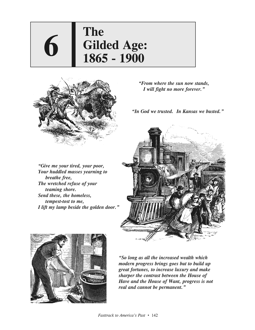| Section 6: The
Gilded Age 1865 - 1900 Fasttrack to America's Past |
 |
| Section 6: The
Gilded Age 1865 - 1900 Fasttrack to America's Past |
 |
 |
Click
on the links below:
|
||||||||
| Historical
photo sets, maps, and
other resources |
1.
Westward
expansion in the Gilded Age 2. Growing cities and immigration 3. Growing industries and new inventions 4. Gilded Age reform movements (workplace safety, labor unions, women's voting rights, and the temperance movement) 5. America grows overseas (Spanish-American War and its results) |
||||||||
| Suggested
historical videos for this section |
America:
The Story of Us, a video
series on DVD produced for the History
Channel, has many very well done
segments related to these topics. Specific segments are
recommended in the pages linked above for historical photo sets, maps,
and other resources. Less
than
$20
for the 3-disc set from Amazon or other retailers. Dear America: So Far From Home Students love this well done dramatization of the story an Irish immigrant girl who takes a job in a textile mill in Lowell, Massachusetts. It's available on VHS from Amazon sellers (click on "See All Buying Options"), or as a digital video purchase, also on Amazon. Masses and Millionaires: The Homestead Strike From The Phoenix Learning Group, this is a good dramatization of the famous strike at a Carnegie steel mill in 1892. Consider skipping the opening scene at a zoo, however, and start instead with the deadly accident in the steel mill to get students right into story. The Men Who Built America A two DVD set of the History Channel mini-series about famous industrialists of the late 1800s / early 1900s. Episode 2, "Oil Strike," for example, has a good dramatization of John D. Rockefeller's work building the Standard Oil Company. (Some reviewers, however, have criticized the accuracy, in another episode, of the reenactment of the Homestead steel mill strike.) |
|
Copyright Notice
Copyright 2023 by David Burns. All rights reserved. Illustrations and reading selections appearing in this work are taken from sources in the public domain and from private collections used by permission. Sources include: the Dover Pictorial Archive, the Library of Congress, The National Archives, The Hart Publishing Co., Corel Corporation and its licensors, Nova Development Corporation and its licensors, and others. Maps were created or adapted by the author using reference maps from the United States Geological Survey and Cartesia Software. Please see the home page for this title for more information. |